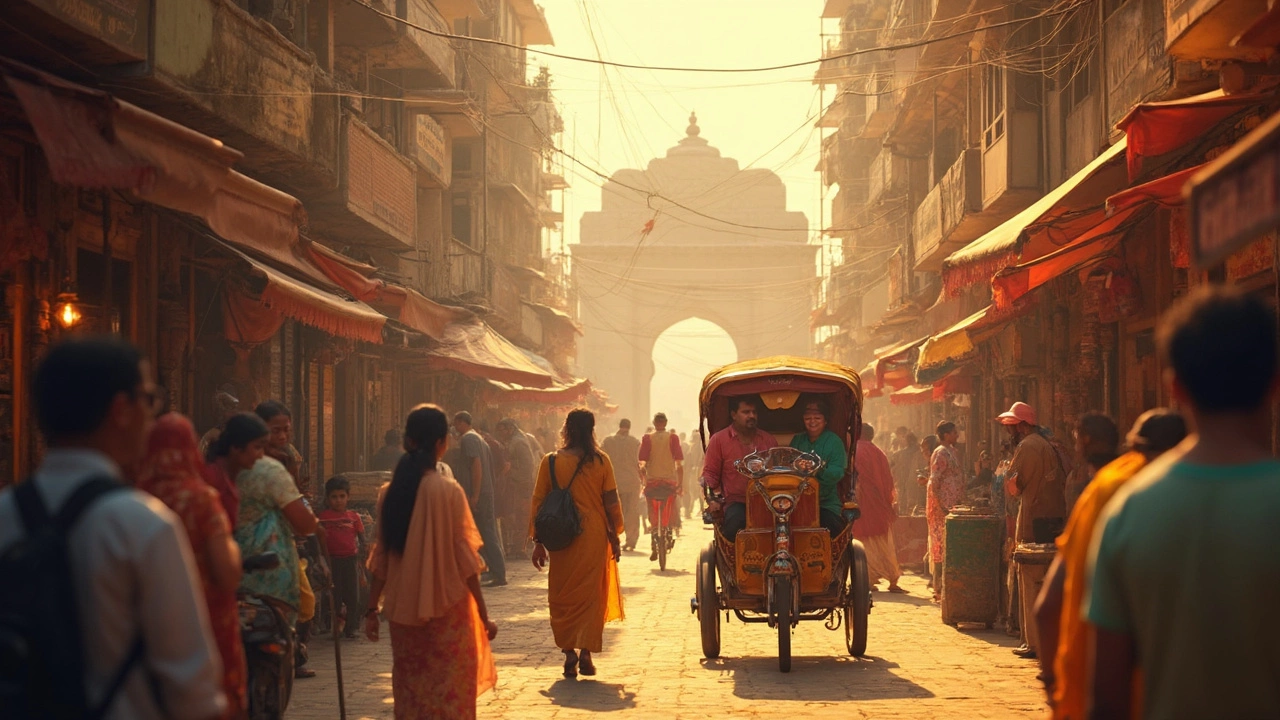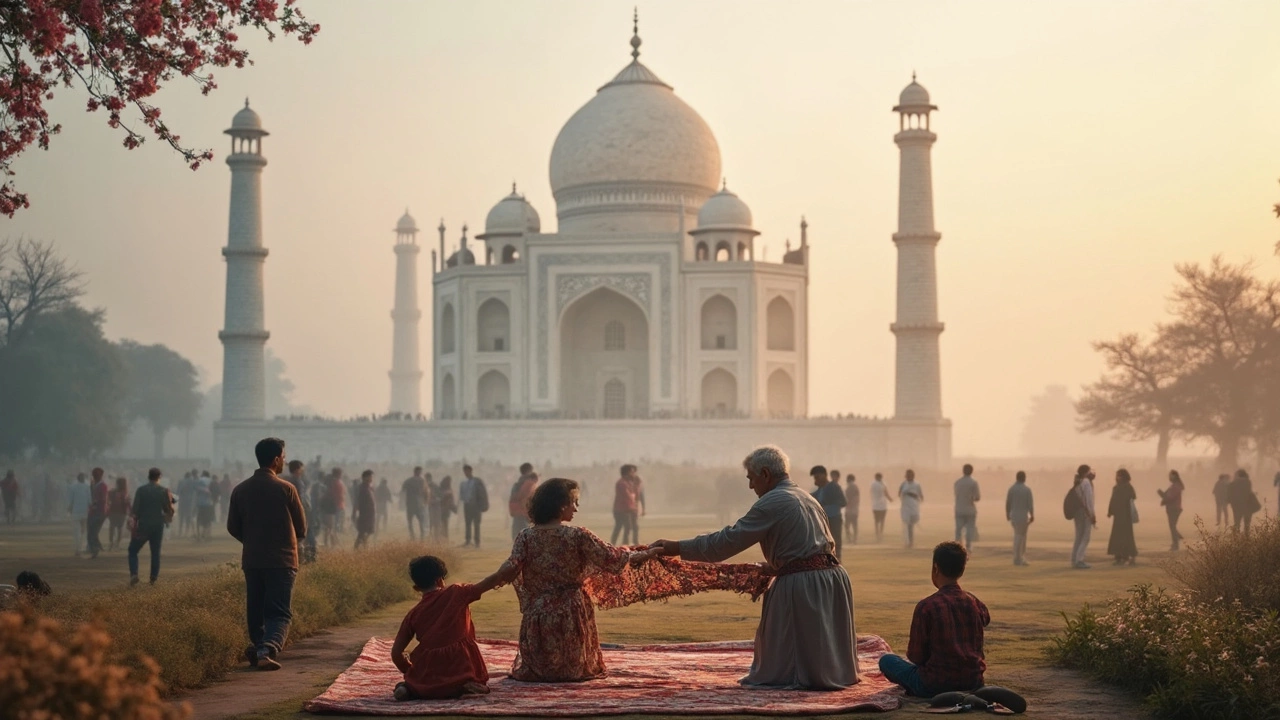Best Month to Visit the Golden Triangle in India: Maximize Your Experience
 Apr, 26 2025
Apr, 26 2025
You’ve probably heard stories about the Golden Triangle—Delhi, Agra, Jaipur—being a must-see in India. But timing isn’t just another detail, it changes your whole experience. Go at the wrong time, and you’re dripping with sweat or lost in giant tour group crowds. The right month, though? Suddenly, you get crisp mornings, short lines at the Taj Mahal, and all the street food your gut can handle.
So let’s get down to what really matters: picking the month that fits your style, whether you love perfect weather, want fewer tourists in your selfies, or just need to dodge India’s famous heatwaves. It’s all about stacking the odds in your favor, so you spend more time exploring and less time melting into the sidewalk.
- Why Timing Matters in the Golden Triangle
- Breaking Down the Best Months to Visit
- What to Expect: Weather, Crowds, and Costs
- Insider Tips for a Smooth Experience
Why Timing Matters in the Golden Triangle
Here’s the thing: the Golden Triangle isn’t just famous for jaw-dropping sights—it’s also known for wild swings in weather, festival crowds, and tourist prices that go up and down like a yo-yo. When you visit shapes nearly everything about your trip: comfort, cost, how much you get to see, and even what’s open when you roll in.
Let’s talk weather. North India can get seriously extreme. In May and June, it’s common for Delhi or Agra to hit 45°C (113°F) in the afternoons. That’s the kind of heat where you just want to camp out in your hotel AC. Flip to December and January, though, and you’ll probably need a light jacket, especially in the morning—a total game-changer for sightseeing.
Crowds are a big deal too. The best month to visit is about more than just heat or cold; it’s dodging those tourist waves. Peak seasons like late December can turn the Taj Mahal into a selfie battlefield. Off-peak times often mean you can actually hear your own thoughts at the big spots, sometimes saving a bunch on hotels too.
Events and festivals can make or break your trip. Holi and Diwali transform cities like Jaipur and Delhi into riotous celebrations, but they also bring road closures, hotel surges, and some next-level traffic. Festivals are incredible if you’re ready for the crowds, but planning ahead is essential if you want to see the best of North India travel without constant hassles.
| Month | Avg. Temperature (°C) | Typical Crowd Level |
|---|---|---|
| January | 8-21 | Medium |
| May | 27-41 | Low |
| October | 19-34 | High |
| July | 27-34 (rainy) | Low |
Long story short: when you go isn’t just about the weather, it’s about shaping your whole India tourism experience to fit what matters to you—comfort, budget, and the stuff you actually want to see.
Breaking Down the Best Months to Visit
If you talk to anyone who's done the Golden Triangle, they’ll tell you: skip the summer if you can. From late March to June, North India cooks you alive with temps that often creep past 40°C (104°F). Monsoon season rolls in right after, with heavy, sticky rain from July through September. It’s not just about getting wet. Flooded streets and train delays can mess with your plans.
The real sweet spot? October to March. That’s when the weather is at its friendliest. Days are warm and sunny, you don’t have to carry an extra shirt for sweat emergencies, and the nights are cool. The parks and historical sites in Delhi, the Taj Mahal in Agra, and those pink streets of Jaipur—they all just look better when you’re not roasting.
Within that window, November and February usually hit the jackpot for most travelers. Why? November brings in the festive mood—think Diwali lights everywhere, plus cooler nights. February, on the flip side, is perfect if you want mostly empty places right before the heat starts creeping in again.
Here’s a quick rundown to help you decide:
- October: Post-monsoon, everything’s fresh, weather is cool, but expect some crowds as festivals kick off.
- November: Diwali, tons of local events, pleasant weather. Hotels fill up fast—book ahead!
- December & January: Peak tourist season, especially around holidays. It gets chilly at night (as low as 5°C/41°F), but daytime is cool and sunny.
- February: Still nice and cool, but crowds start thinning. Flowers are everywhere—great for photos!
- March: Getting warmer, Holi festival brings color and craziness if you’re into that.
| Month | Avg. High (°C) | Avg. Low (°C) | Main Events |
|---|---|---|---|
| October | 32 | 18 | Navratri Festivals |
| November | 28 | 13 | Diwali, Pushkar Camel Fair |
| December | 21 | 7 | Christmas, New Year |
| January | 20 | 5 | Republic Day, Jaipur Literature Fest |
| February | 24 | 9 | Valentine’s, Flower Festivals |
| March | 29 | 15 | Holi |
So, for smooth travel, comfortable weather, and lively events—October through March is your gold standard. Just remember, these are the months when everyone else wants to be there too, so booking early saves a lot of headache. Choose the month that fits your vibe: do you love festival energy, cooler months, or avoiding the thickest crowds? That calls the shots on when you should go.

What to Expect: Weather, Crowds, and Costs
When you’re mapping out your Golden Triangle trip, three things shape your experience big time: the weather, how many people are crowding the sights, and what it’s all going to cost. Let’s break down the real deal so you know exactly what you’re getting into, whatever month you choose.
Weather is a huge player in North India travel. The top months—October, November, February, and March—bring awesome weather. Daytime stays comfy between 20°C–30°C (68°F–86°F), so you’re not baking or freezing. Early mornings and nights can feel cool; keep a light jacket handy. December and January can dip to 5°C–7°C (41°F–45°F) at night, especially in Delhi and Agra. But summer, from April to June? Brutal. Temperatures often blow past 40°C (104°F), and sightseeing turns into a challenge nobody’s trying to win. Monsoon season (July to September) soaks the streets, causes sudden delays, and can turn the Taj Mahal’s marbles slippery.
Crowds hit their peak when the weather’s best—mainly November and February. You’ll see big tour groups at famous forts and the Taj Mahal. Still, early mornings or late afternoons help dodge the rush. If you’re chasing empty selfies and relaxed markets, consider late September or early March. These months ride right after peak but before the extreme weather swings back in. Here’s how tourist footfalls stack across the seasons:
| Month | Weather | Crowds | Notes |
|---|---|---|---|
| Oct–Nov | Pleasant | High | Festivals, peak rates |
| Dec–Jan | Chilly | Medium | Foggy in mornings |
| Feb–Mar | Pleasant | High | Spring, great visibility |
| Apr–Jun | Hot | Low | Uncomfortably hot |
| Jul–Sep | Rainy | Low | Possible delays |
What about costs? Expect prices for hotels, tours, and flights to spike during peak season—October, November, and February. Sometimes, room rates double compared to the roasting summer months. You can snag good deals in July and August, but you’ll pay with soggy shoes and missed sunsets. Pre-book popular hotels and train tickets for October–March. Last-minute deals almost vanish during festival seasons like Diwali and Holi.
As Lonely Planet notes,
"The sweet spot for India’s Golden Triangle is post-monsoon and pre-summer—October through March—when travel is at its most comfortable and scenic."That’s not just a travel slogan; it’s how the region works. Smarter planning upfront means a much smoother experience out there.
Insider Tips for a Smooth Experience
If you’re hitting the Golden Triangle for the first time, a few simple changes can make your trip go from decent to epic. Plan ahead, but also leave wiggle room—trains can run late and traffic in Delhi doesn't care about your tight schedule.
- Start early, especially at major sights. Doors at the Taj Mahal open at sunrise, and trust me, the early hour is miles better than elbowing through afternoon crowds. The light’s best for photos, and it’s way cooler.
- Book your tickets and hotels in advance if you’re going in peak months (Oct–March). Good stays with views of Jaipur’s forts or Agra’s rooftops get snapped up quickly. I once waited too long and ended up in a place with questionable walls and aggressive monkeys—so yeah, plan ahead.
- Use local guides when you can. Folks at the monuments sometimes drop facts you won’t find in guidebooks—like how to find the less crowded photo spots, or which vendor makes the safest chai near Jama Masjid.
- Pack layers, even in winter. It gets surprisingly cool at night, but midday sun can make you sweat. A light jacket or scarf does wonders—especially in January and February.
- Hassle for prices, but not everything is a scam. Bargaining is normal at markets, but don’t haggle at restaurants or with official ticket counters.
- Stay hydrated, but buy sealed water bottles only. Tap water is an adventure you don’t need.
- Trains are great, but quick cabs or private drivers save time if you’re short on days. Most drivers know the Delhi-Agra-Jaipur circuit by heart. Ask for recommendations—they’re usually loaded with stories.
Here’s a look at how long it takes to get between the three main cities. Helps you avoid surprises:
| Route | By Train | By Car |
|---|---|---|
| Delhi to Agra | 1.5–2.5 hrs (Gatimaan/Shtbdi Exp.) | 3–4 hrs |
| Agra to Jaipur | 4–5 hrs | 4–5 hrs |
| Jaipur to Delhi | 4.5–6 hrs | 5–6 hrs |
If budget isn’t your top worry, try a guided group day trip or a private tour for one leg of the journey. They usually include local food spots and hidden gems. Granted, you pay more, but you do less thinking and more enjoying.
No trip to North India goes perfect from start to finish, but with a few of these moves, you’ll have way fewer headaches and a bigger chance of loving the chaos.